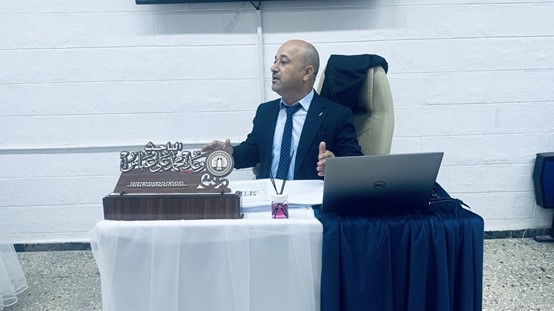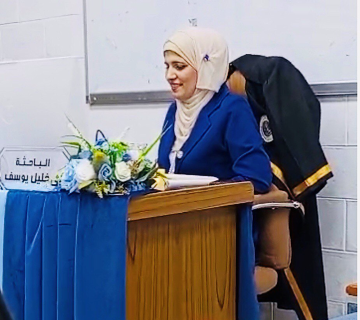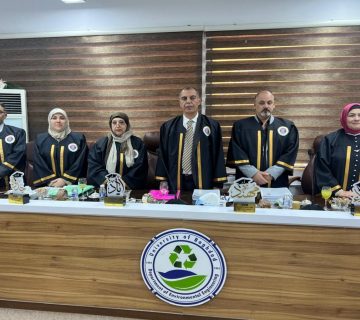Environmental Engineering Department at the College of Engineering, University of Baghdad, held PhD dissertation examination titled:
“Electrode Modification Using Eco−Friendly Nanomaterials to Improve Energy Recovery from Hospitals Waste Water in Microbial Fuel Cell”
By the student Waad Muhammed Ali Abbas and supervised Prof.Dr. Zainab Zyad Ismaal on Tuesday 27/5/2025, in the Environmental Engineering discussion hall. The examination committee consisted of Prof.Dr. Wadood Taher Mohummed as Chairman, and the membership of Prof.Dr. Khalid Khazaal Hummady, Prof.Dr. Zyad Tariq Abd Ali, Assist.Prof.Dr. Ghufran Farroq Jumaa and Assist.Prof.Dr. Hussein Gabbar Kadhim. After conducting the public discussion and listening to the student’s defense, the dissertation was accepted. It was summarized as follows:
Microbial fuel cell (MFC) is an attractive technique which utilizes bacterial species for anaerobic biodegradation of organic contaminants in the contaminated effluents and simultaneously produce power. Introduction of advanced nanomodified anode is considered as an efficient approach to boost and promote the performance of MFC by facilitating and increasing the adhesion of biofilm, and then enhance the transport of extracellular electron. Getting benefits from the outstanding electrical characteristics, biocompatibility, porosity, and surface area, the nanomaterials display enormous potentials in improving the power output of MFC.
In this study, a novel application of three types of food-grade natural nanomaterials was investigated for nanomodification of anodes in MFCs. The tested natural materials included flaxseeds (FSNP), chia seeds (CSNP), and garden cress (GCNP). Also, the potential of using graphene oxide (GONP) and titanium dioxide (TiO2NP) for nanomodification of anodes was investigated for comparison purposes. Eight mediatorless cylindrical-shaped dual chambered MFCs were identically designed, constructed, setup, and continuously operated for 90 days for simultaneous treatment of real hospital wastewater (HWW) and power generation. The cylindrical-shaped anodes in MFC1 were maintained uncoated (bare), whereby, they were coated with pristine MWCNTs, acid activated-MWCNTs (F-MWCNTs) in MFC2, and MFC3, respectively. The coating of anodes in MFC4, MFC5, MFC6, MFC7, and MFC8 was performed by using GONP/F-MWCNTs, TiO2NP/F-MWCNTs, FSNP/F-MWCNTs, CSNP/F-MWCNTs, GCNP/F-MWCNTs, respectively. The bare and coated electrodes were subjected to various tests including contact angle, cyclic voltammetry, SEM, FTIR, and surface area. The results of these aforementioned tests indicated the preference of nanocoating of anodes compared to uncoated anodes.
MFCs performance was fully considered according to the removal efficiency of organic matters (COD) and power output as well. The results of operating the MFCs revealed the effectiveness of nanocoated anodes, in particular, with natural nanomaterials versus the uncoated anodes. Higher efficiencies of COD dissipation from HWW were 79.86%, 81.65%, 82.56%, 88.93%, 87.29%, 91.60%, 86.10%, and 91.56% observed in MFC1, MFC2, MFC3, MFC4, MFC5, MFC6, MFC7, and MFC8, respectively. However, the treated effluents from MFCs were subjected to aerobic treatment to degrade the HWW-components which are not biodegradable under anaerobic conditions. The final removal efficiencies of COD after aerobic treatment for MFCs-effluents were 84.50%, 90.89%, 93.45%, 97.36%, 95.67%, 98.97%, 96.34%, and 98.53%, respectively. Maximum power outputs were 454.7, 648.1, 831.7±20, 892.0, 898.0, 1072.7, 1042.8, and 1098.7 mW/m3 obtained in MFC1, MFC2, MFC3, MFC4, MFC5, MFC6, MFC7, and MFC8, respectively. Maximum columbic efficiency (CE) was 4.77 observed in MFC6, whereby, maximum normalized energy recovery (NER) was found to associated with natural food-grade nanocoating. Three types of mathematical models were adopted including electrochemical model, Butler–Volmer–Monod (BVM) model, and four different bacterial growth models. Results predicted by the electrochemical polarization model were well fitted the experiential results with R2 ranged from 0.935-0.981, except for MFC4 and MFC5, R2 values were 0.632 and 0.792, respectively. Excellent consistency was obtained between experimental results and those predicted by BVM model with R2 values in the range of 0.965- 0.998.
Four bacterial growth models including Halden, Monod, Blackman, and Teissier were adopted to describe the relation between biomass growth and substrate utilization. The results revealed that Blackman model fitted very well with experimental results with determination coefficient (R2) of 0.999 for all MFCs except for MFC3 and MFC8 the R2 values were 0.810 and 0.797, respectively. However, the match of experimental results with the results predicted by the adopted models was in the order of Blackman > Monod > Halden > Teissier.
Overall, natural food-grade nanomaterials showed great potential for sustainable enhancement of MFC performance in wastewater treatment and power generation.
The Recommendations of this dissertation.
1- Investigate the validity and performance of other types of electrodes rather than graphite which should be favorable with bacterial species.
2- Investigate the validity and performance of other configurations of MFCs, like anodic and cathodic chambers arrangements as well as feeding pattern.
3- Evaluate the performance of the suggested cylindrical-shaped dual-chambered MFC for the treatment of different types of real wastewater such as s refinery, textile, and dyes wastewaters.
4- Examine the effectiveness of other mixing percentages natural food-grade nano materials with F-MWCNTs.








